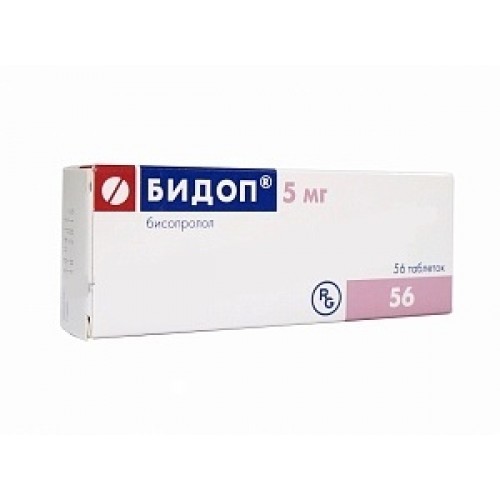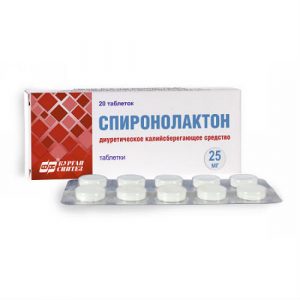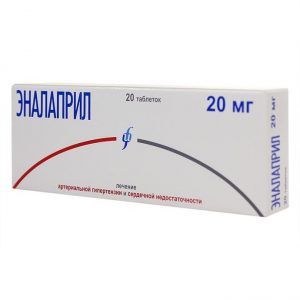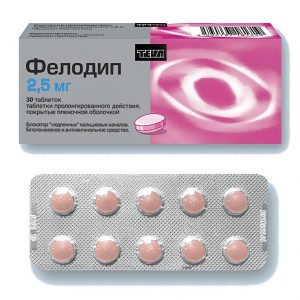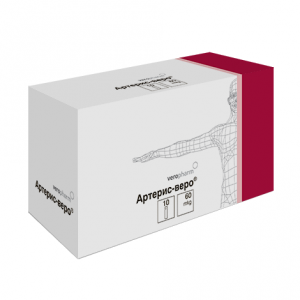Description
Release form
Tablets.
Packing
56 pcs.
Pharmacological action
Bidop is a selective beta1-blocker without internal sympathomimetic activity, does not have a membrane-stabilizing effect. Bidop reduces plasma renin activity, reduces myocardial oxygen demand, reduces heart rate (at rest and during exercise).
It has hypotensive, antiarrhythmic and antianginal effects.
Blocking 1-adrenergic receptors of the heart in low doses, it reduces the cAMP production from ATP stimulated by catecholamines, reduces the intracellular current of calcium ions, has a negative chrono-, dromo-, batmo- and inotropic effect, inhibits conduction and excitability, and reduces myocardial contractility.
With increasing doses has a beta2-blocking effect.
Indications
Arterial hypertension prophylaxis of angina attacks.
Contraindications
hypersensitivity to bisoprolol and other beta-blockers
shock (including cardiogenic) collapse
acute heart failure, pulmonary edema
chronic heart failure in the stage of decompensation (including cardiogenic shock)
AV block II ² III stage, sinoatrial block, syndrome of sinus node weakness
severe bradycardia
angina pectoris Prmetzmetala
cardiomegaly (cardiomegaly hypotension (sardlkp sAD bronchial asthma and COPD with a history of
simultaneous administration of MAO inhibitors (except MAO-B inhibitors)
late stages of peripheral circulation disturbance
Raynaud’s disease
pheochromocy ohm (without the simultaneous use of alpha-blockers)
metabolic acidosis
age of 18 years (effectiveness and safety have been established).
Use during pregnancy and lactation
Use Bidop during pregnancy and during breastfeeding is possible if the benefit to the mother outweighs the risk of side effects in the fetus and baby.
Special instructions
Monitoring of patients taking Bidop should include measurement of heart rate and blood pressure (at the beginning of treatment daily, then 1 time every 3-4 months), ECG, determination of blood glucose in patients with diabetes mellitus (1 time in 4 ² 5 months).
In elderly patients, it is recommended to monitor renal function (1 time in 4-5 months).
Composition
1 tablet contains 5 mg bisoprolol hemifumarate.
Excipients:
lactose monohydrate,
microcrystalline cellulose,
magnesium stearate, crospovidone,
pigment grade PB 27215 beige (lactose monohydrate 87%, iron oxide red and yellow 13%).
Dosage and administration
Inside, in the morning, on an empty stomach, without chewing, 2.5 5 mg bidop once.
If necessary, increase the dose to 10 mg once a day.
The maximum daily dose is 20 mg per day.
Side effects
Side effects observed with the use of the drug Bidop, classified into categories depending on the frequency of their occurrence: very often (? 1/10) often (? 1/100, <1/10) infrequently (? 1/1000, <1/100) rarely (? 1/10 000, <1/1000) is very rare (<1/10 000), including single messages. From the side of the central nervous system and peripheral nervous system: infrequently – increased fatigue, weakness, asthenia, dizziness, headache, sleep disturbances, depression, anxiety, confusion or short-term memory loss rarely – hallucinations, myasthenia gravis, nightmare dreams, convulsions (v. hours in the calf muscles), paresthesia in the limbs (in patients with intermittent claudication and Raynaud’s syndrome), tremor. On the part of the sensory organs: rarely – impaired vision, decreased secretion of lacrimal fluid, dryness and soreness of the eyes very rarely – conjunctivitis. From the side of the cardiovascular system: very often – sinus bradycardia, palpitations often – marked decrease in blood pressure, manifestation of angiospasm (increased disturbance of peripheral circulation, cooling of the lower extremities, Raynaud’s syndrome) infrequently – orthostatic hypotension, impaired myocardial conduction, AV block (up to to the development of complete lateral blockade and cardiac arrest), arrhythmias, weakening of myocardial contractility, development of chronic heart failure (swelling of the ankles, feet shortness of breath), chest pain. From the digestive system: often – dry oral mucosa, nausea, vomiting, abdominal pain, constipation or diarrhea rarely – impaired liver function (dark urine, yellowness of the sclera or skin, cholestasis), taste changes, hepatitis, increased enzyme activity liver (ACT, ALT), hyperbilirubinemia, hypertriglyceridemia. From the respiratory system: infrequently – difficulty breathing when prescribed in high doses (loss of selectivity) and / or in predisposed patients – laryngo- and bronchospasm rarely – nasal congestion. From the endocrine system: hyperglycemia (in patients with non-insulin-dependent diabetes mellitus), hypoglycemia (in patients receiving insulin), hypothyroid state. Allergic reactions: rarely – skin itching, rash, urticaria. Dermatological reactions: rarely – increased sweating, skin hyperemia very rarely – exanthema, psoriasis-like skin reactions, exacerbation of psoriasis symptoms, alopecia. From the hemopoietic system: in some cases – thrombocytopenia (unusual bleeding and hemorrhage), agranulocytosis, leukopenia. Other: infrequently – arthralgia rarely – back pain, weakening libido, decreased potency, withdrawal syndrome (increased angina attacks, increased blood pressure). Drug Interactions Allergens used for immunotherapy or allergen extracts for skin tests increase the risk of severe systemic allergic reactions or anaphylaxis in patients receiving bisoprolol. Iodine-containing radiopaque drugs for iv administration increase the risk of anaphylactic reactions. Phenytoin with iv administration, drugs for inhalation general anesthesia (hydrocarbon derivatives) increase the severity of the cardiodepressive effect and the likelihood of a decrease in blood pressure. Changes the effectiveness of insulin and oral hypoglycemic drugs, masks the symptoms of developing hypoglycemia (tachycardia, increased blood pressure). It reduces the clearance of lidocaine and xanthines (except theophylline) and increases their concentration in plasma, especially in patients with initially increased clearance of theophylline under the influence of smoking. Antihypertensive effect is weakened by NSAIDs (sodium ion retention and prostaglandin synthesis blockade by the kidneys), corticosteroids and estrogens (sodium ion retention). Cardiac glycosides, methyldopa, reserpine and guanfacine, slow calcium channel blockers (verapamil, diltiazem), amiodarone and other antiarrhythmic drugs increase the risk of developing or worsening bradycardia, AV blockade, heart failure and heart failure. Overdose Symptoms: arrhythmia, ventricular extrasystole, severe bradycardia, AV blockade, severe BP, chronic heart failure, cyanosis of nails of the fingers or palms, difficulty breathing, bronchospasm, bronchospasm. Treatment: gastric lavage and the appointment of adsorbing drugs symptomatic therapy: with developed AV blockade – in / in 1-2 mg of atropine, epinephrine or staging of a temporary pacemaker for ventricular extrasystole – lidocaine (class IA drugs are not used) when reducing blood pressure – the patient should be in Trendelenburg if there is no evidence of pulmonary edema, for maintenance of chronotropic and inotropic action and elimination of the expressed decrease in blood pressure) at heart failure – cardiac glycosides, diuretics, glucagon at convulsions – in / in diazepam at a bronchosphere azme – beta2-adrenostimulants inhalation. Storage conditions Store in a dry, dark place out of the reach of children, at temperatures not exceeding 20 ° C. Shelf life 3 years. Deystvuyushtee substance Bisoprolol Terms and conditions prescription Gedeon Richter-Rus Vengriya
